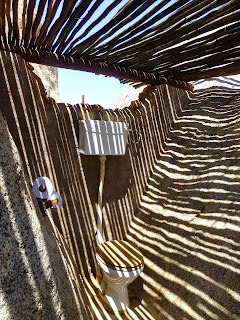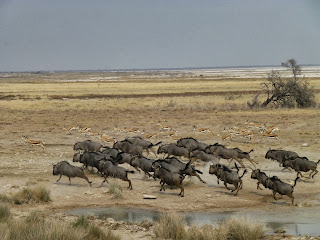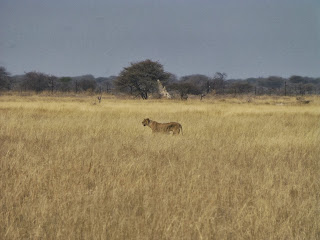We’re leaving Etosha today, but we’ve had
such a great time we can’t be too sad.
Today is pretty much a driving day as we head north towards the Caprivi
Strip. We stop in Tsumeb – a
surprisingly neat and tidy little city – for groceries and then continue on
through Grootfontein, another well-kept town.
A couple of hours later we pass the Red
Line – this is a veterinary control fence put in place to stop the spread of
food and mouth (and other diseases) from stock in the north to stock in the
south. South of the line is commercial
farming and big ranches, north of the line is subsistence farming. The guidebook describes it as the line
between the developed and developing world.
We take that with a pinch of salt until we cross the line. Almost immediately you can see the change and
it’s as if we’ve entered ‘real’ Africa.
There are no more neat and tidy towns, just clusters of mud and straw
huts.
Donkeys, cows, goats and clusters of school
children line the road (giving me the heebie-jeebies, as the speed limit is a
fairly solid 120kmh).
Our destination is Rundu and we arrive in
the early afternoon. It’s a bustling and
slightly chaotic city, but it feels friendly enough. We’ve booked a campsite at a lodge a little
way out of town. It’s right on the banks
of the Okavango River, overlooking Angola.
The campsite is lovely, with it’s own toilet and shower, and the grounds
are lovely too, with friendly horses and aloof peacocks. There’s free wifi, so we park ourselves in
the bar overlooking the river for a few sundowners. I see one man walking across the river to
Angola and a bit later the traffic picks up, with little canoes taking people
back and forth (legally, illegally? no one seems to care either way).
I try to persuade Nick to have a ride over
but he’s not having it.
After dinner at our campsite we crawl up
into our little tent to sleep.
Saturday 21 September
It’s another driving day today, this time
heading east. The road is pretty similar
to yesterday: we’re on a straight, tar road that cruises past more little
villages and their livestock. A couple
of hours into the morning we pass into the Caprivi Strip. This area was once devastated by war and
poaching but has now been turned into a national park – the Bwabwata National
Park. We’re only transiting, so we don’t
get to explore, but there are plenty of signs warning us of elephants, wild
dogs and the like. We do spot one ellie
in the distance but apart from that it’s all donkeys, goats and cows, so we
even brave a picnic lunch under the trees.
By early afternoon we’re in Katimo Mulilo –
about as far out of Namibia as you can get while still being in Namibia. We check into a campsite and tonight we’re on
the banks of the Zambezi River, overlooking Zambia. The sign next to our tent warns us about
crocodiles and hippos.
We
sit back, watch the sunset and wait to see if we get any visitors.
Janet adds: So much for the peace and quiet
of the Zambezi. We’ve managed to pick a
campsite that’s overrun with day-trippers.
Most of it has been turned into a car park and even when we do find a
spot to get our tent up we’ve got people wandering through our camp
constantly. The toilets get trashed and
they manage to blow out the electricity (and the water with it). Of course there’s not a croc or hippo to be
seen amongst this carnage.
Sunday 22 September
Luckily most of the partying day-trippers
cleared out after they blew the lecky and had no more power, so things quieted
down and we could get some seep. We’ve
travelled east a fair way and the sun is up considerably earlier in the morning
(and down earlier too in the evening), so we’re up and about nice and early
this morning.
We’re crossing the border into Botswana
today and we’re not far from the border crossing. I’m a little nervous about it, but in the end
we’re through in no time with no hassles at all. Weirdly (or not?) Botswana feels and looks
quite different. As soon as we’re over
the border we see baobab trees sprouting up everywhere and cows are happily
grazing on the low-lying riverbanks.
We’re transiting through Chobe National
Park on the way to Kasane, but we’re not detouring for any game-driving
today. Still, just as we enter the park
we come across a huge herd of buffalo.
With that, we’ve now seen all 5 of the Big 5 on this trip
It’s still early as we arrive in Kasane and
we head straight to the supermarket.
Botswana does not allow any meat, dairy, fruit or veg across the border,
so we’re low on supplies and as it’s a Sunday we figure we’d best get in there
quickly.
We’d planned to camp at the Chobe Safari
Lodge. They don’t take pre-bookings for
campsites, but as it’s only half 11 we figure we’ll have no worries getting
in. Wrong. The campsites are all gone and even their
rooms are fully booked. We take a short
stroll to take in the luxury we won’t be enjoying and sneakily take in the
river views over onto grazing elephants, then pile back into the car to try to
find an alternative.
It’s a hot hour or so in the car before we
finally find somewhere that fits the bill.
We’re a ways out of town but we have a lovely campsite (with it’s own
toilet and shower!) near the riverbank.
Like most places round here they offer
wildlife river cruises and we waste no time booking on one for this
afternoon. As the time nears we’re a bit
concerned as to what we’ve got ourselves into.
We were hoping for a nice, small trip but as it turns out we’re sharing
the boat with a big German group and a smaller Dutch group. It’s all a little too crowded and pushy for
me, but I needn’t have worried. By the
time we get out on the water everyone calms down and the beauty of the setting
steals over.
There’s an island in the middle of the
Chobe River that is packed with wildlife – huge herds of buffalo, antelope and
elephants at every point on the horizon, all beautifully illuminated by the
setting sun.
Hippos stick their heads out of the water
around the boat
and a couple even haul themselves on land
to graze. We spot fish eagles, monitor
lizards, giraffe, baboons and some hungry looking crocs.
It’s dark when we get back and we decide to
treat ourselves to a meal out. The
service and the food leave much to be desired (I tuck into a surprisingly tasty
cauliflower and carrot pizza), but the setting on the river with the sound of
hippos grunting below can’t be beat.
Janet adds: there are elephants literally
everywhere here. Sure, they’re in Chobe
National Park in huge numbers, but they’re also at the roadside and on the
riverbanks. We’ve camped up against the
fence and when we got back to our campsite this evening we found elephants
munching on the trees just across from our camp – no more than 5 meters away. Gotta love Botswana already.
Monday 23 September
We’ve decided to go game-driving today
along the riverfront in Chobe. We’re in
no major rush and don’t enter the park until mid-morning. The driving is a little different to what
we’re used to: this is proper 4x4 territory as we bump along sandy little
tracks, creep round gaping ditches and ease our way over rocks. Nick even gets to play the Good Samaritan and
tows a family of fellow travellers that have got themselves stuck in the sand
(and yes, he enjoyed every second of his daring rescue).
Away from the river the landscape is
surprisingly bare, but there’s life everywhere – more elephants, plenty of
giraffe, impala, kudu, warthogs, zebra and all sorts of other creatures.
A short while before lunchtime we strike it
lucky (and yes, the lucky earrings are on).
We take a little side-loop and happen upon a small cluster of cars. There, no more than a few meters from the
road, is a gorgeous leopard.
She’s perched up in the tree on full
display, quietly enjoying her day. It’s
a fantastic spot and we’re thrilled to get such a good view of this elusive
cat.
We’re buzzing after that and we know we’re
not going to get another sighting that good.
The driving is still lovely though and the animals keep us
entertained.
By mid-afternoon the car is going strong
but our aging bones could do with a break from the rattling, so we hop back
onto the tar road and head for town. We
take care of a few errands and then head back to the campsite for a well-earned
beer.
Janet adds: we woke up a couple of times in
the night hearing the elephants right nearby.
When I got up this morning they were just on the other side of the
fence. I got eyeball to eyeball with
this big fella – quite a way to start the day.
Tuesday 24 September
We’ve booked a day trip to Victoria Falls
today. It’s only just over the border in
Zimbabwe (or Zambia – depending on which you choose). Zimbabwe seems to be the easiest option and
the spot with the better views, so that’s what we go with.
The tours are a well-oiled machine. We’re picked up at 7.30 and in about 10
minutes we’re at the border. We had no
idea we were that close. We get stamped
out of Botswana and enter Zimbabwe. For
once it’s a whole lot easier travelling on my green South African passport than
the red UK one. Most things in this part
of the world come at a reduced rate for South Africans and I don’t need a visa
for Zimbabwe, whereas Nick has to buy one at the border. Despite paying 50 US $ for it, they still
manage to get his name wrong.
Still, it doesn’t take long to get through.
Another 40 minutes or so up the road and
we’re at the falls. Our guide drops us
off, arranging a pick up time for a few hours later. There’s a lovely cliff-top walk through rainforest
(the constant mist from the falls creates a rainforest like climate) that takes
in various views of the falls. Our first
full view of the ‘smoke that thunders’ is breathtaking.
The sheer height, breadth and volume of the
falls are overwhelming. We’re here at a
drier time of year and the falls aren’t in full flow. There are lots of ‘gaps’ creating a series of
individual falls rather than one continuous curtain.
That said, when the falls are in full flow
it’s said to be very difficult to get a glimpse of them as the mist they throw
off obscures the view. Even at this
lower flow we get rather pleasantly misted with cool water – it’s hot today.
Once we’ve taken in all 16 viewpoints and
watched someone bungee off the bridge our guide picks us up and drops us off
somewhere convenient for lunch. We get
delicious sandwiches and salads out on the terrace. I like trying local beers and as we’re only
in Zimbabwe for the day I couldn’t resist ordering a Zambezi with my salad. It’s a nice enough beer, but I’m not good at
daytime drinking at the best of times.
The beer combined with the heat is enough to zombify me. Luckily we’ve got time for a relax on some
comfy sofas before a quick look round the local craft market. With that we’re loaded back onto our
mini-bus, repeat the border process in reverse and are safely back at our
campsite by mid-afternoon.
Janet adds: no ellies at the campsite today
(although Nick says he saw loads from the bus – I must’ve dozed through those),
but we did have some warthog visitors.
Wednesday 25 September
At the very last minute we’ve managed to
secure a booking at Chobe’s Savute campsite that will link in with the nights
we’ve already booked in the Moremi Game Reserve. This means that we will be able to transit
Chobe into Moremi, rather than taking the more conventional tarred route around. I’m thrilled to bits as this is game-driving
taken to the extreme. It’s also bought
us a bit more time in Kasane, so we’ve got time to relax and take things easy.
Still, we could do with a change of
scenery, so we decide to move campsites.
There’s a campsite even further out of town that’s come highly
recommended, so we head over there early on to see if we can get a spot. There are, I must reiterate, elephants
everywhere in Kasane. On the drive over
we pass at least 2 dozen of them just at the side of the main highway. We’re in
luck and get ourselves a campsite.
We take a quick journey back to town to
pick up a few bits and then get ourselves settled in for the day. We’ve got a nice site with it’s own
toilet/shower, kitchen area and shaded porch, all gloriously adorned with
starlings.
It’s roasting today, so we’re not good for
much except collapsing in the shade.
There is, however (drumroll please), free wifi – which makes it doubly
good for doing nothing.
The free wifi and snazzy campsites are not
why we’re staying here though. The
campsite is in the middle of the Kasane Forest Reserve, which sits adjacent to Chobe. That means there’s an awful lot of wildlife
about. The campsite is unfenced, so
creatures can wander through as they please, and it’s centered on a watering
hole. Perfect. There’s a lovely decked area with a bar
overlooking the watering hole and we spend large chunks of the afternoon and
evening here. Big groups of elephants
keep coming in for drinks – 10, 15, 25 of them at a time.
It’s fascinating to watch them drinking,
bathing themselves with mud and jostling for position. Sat up in the deck you feel quite removed
from them, though they’re no more than 20 metres away, but as you come down you
realize that they really are right there.
And if you want to get even closer, there’s a little underground bunker
that’s been built. You can walk through
a narrow tunnel to the bunker situated right at the watering hole for ground
level views of these giants up close.
In the background are warthogs, kudu,
monkeys and giraffes. Baboons roam the
campsite freely too, so we’re careful to keep everything properly packed away.
Somehow, between elephant watching, we
manage to get the tent up, light a good fire and cook ourselves some food. Then it’s time to leave the ellies to their
bickering and hit the sack.
Thursday 26 September
It’s another day of relaxation and
preparation for us today. After a few
campsite chores I position myself on the deck for more elephant viewing. It’s becoming like a soap opera for me and
I’m properly hooked: getting involved in their rivalries, picking out the
bullies, cooing over the babies.
There is one young bull with a badly
injured foot and I sit, almost in tears, watching him limp around and be pushed
about. A few big bulls do come to his
rescue though, chasing off the bullies and standing watch to give him a chance
to get a drink of water. It’s breaking
my heart, but I’m reliably informed that this may be a good news story rather
than a tragedy. This young one got
trapped in a snare a month ago. An
elephant charity/group managed to dart him, do what they could with the wound
and pump him full of penicillin, so the fact that he’s going strong a month
later is a testament to his strong will.
It’s probably a good thing we’re leaving
tomorrow, or I’d be giving them all names and starting to jot notes in a
journal.
The afternoon is spent getting ourselves
provisioned up for the next few days.
We’re only in the park for 3 nights but you’d think we were about to
embark on an arctic expedition with the way I’m planning. Once we’ve got food, diesel and beer we head
back to the campsite for my next elephant fix.
Janet adds: wood is delivered free to our
campsite everyday as an extra perk.
Today’s bits are huge and Nick is in fire-making heaven. Sat by the fire watching ellies graze under
nearby trees… I’m in heaven too.





















































